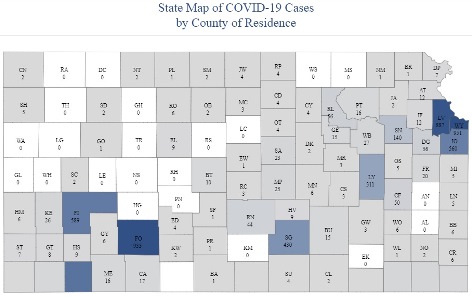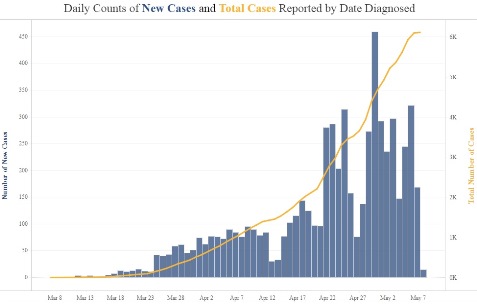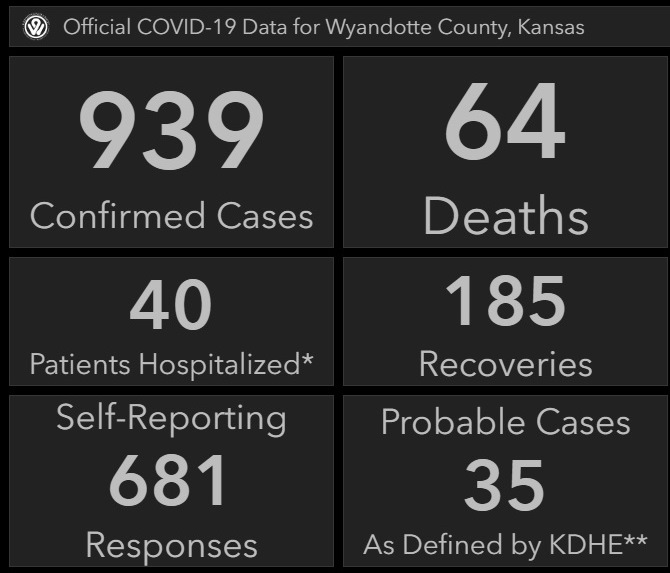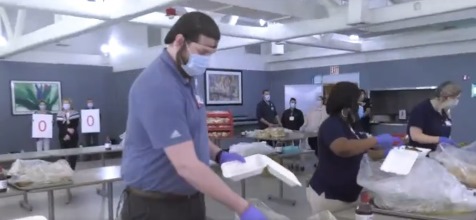


The number of positive COVID-19 cases in Wyandotte County rose to 939 at 11:05 a.m. Thursday, while there were no increases reported in deaths or hospitalizations Thursday morning, according to the Unified Government COVID-19 webpage.
It was an increase of 33 cases in Wyandotte County since the 1:40 p.m. Wednesday report.
Kansas reported an increase of 410 confirmed and probable cases on Thursday morning, to total 6,144, according to figures from the Kansas Department of Health and Environment. The state has started counting confirmed with probable causes on Thursday, a change from the previous confirmed total.
There were 147 deaths in Kansas, an increase of three, according to KDHE. Hospitalizations in Kansas increased by 16, to total 587, statewide.
On Wednesday, Dr. Lee Norman, Kansas secretary of health, stated in a news conference that it is important not to focus on one day’s numbers but to watch the overall trend lines as time goes on. Sometimes they see batch numbers from local communities come in over a few days together, not coming in the first day. There have been increases in testing recently, he said.
He said the state is monitoring 75 outbreaks.
Thirty clusters are in private companies statewide, with 339 cases and four deaths; 22 are in long-term care facilities, with 498 cases and 81 deaths; eight are in church and church-related gatherings, with 110 cases and eight deaths; six are in meatpacking plants with 985 cases and two deaths; three are in group living arrangements, with 40 cases and zero deaths; three are in correctional facilities with 479 caes and two deaths; and three are in health care facilities, with 21 cases and zero deaths.
At Lansing Correctional Facility, testing of all inmates was completed on May 5 and staff will finish testing by early next week, Dr. Norman said. Most of the staff have already been tested, he said.
He said COVID-19 cases spread quickly in prisons. It’s possible there were a certain number of cases at Lansing before it was recognized as such, he said. There was probably a number of asymptomatic people there before the numbers rose, he believes.
Gov. Kelly said there is now a system to evaluate inmates who might be released early, and they will continue to verify who is eligible and is at low risk. She also said some inmates who have been eligible have chosen not to be released, as they would be placed in house arrest, not actually released.
KDHE has loosened the guidelines for testing, with 60,000 testing kits a month available, and now anyone with symptoms can be tested, he said. Symptoms will still be required for a test, he said, such as fever, cough, chills, muscle pains and aches, malaise, headache, sore throat, lower respiratory symptoms, difficulty breathing, the loss of smell or taste, and diarrhea. Two or more of the symptoms are required through KDHE tests, while private tests require one or more symptoms, he said.
The state is now working with labs that are developing a saliva test, and a serum test is being worked on, he said. The goal is to have an antibody test that is specific to COVID-19, not the viruses that cause the common cold, he added.
The University of Kansas Health System reported 26 COVID-19 patients today, with nine in the intensive care unit. There were some discharges recently, according to Dr. Dana Hawkinson, medical director of infection prevention and control at KU Health System. He said he hopes the trend of discharges continues.
Dr. Steve Stites, chief medical officer at the KU Health System, said it feels like the numbers of cases are escalating around them, while the number of cases seems to be declining in the hospital.
Dr. Hawkinson said the experience here has been different from New York, where there were a large number of hospitalizations and critical patients. He is hoping that this area won’t have the large numbers of hospitalizations and the surge that the East Coast experienced, and that this is the new normal.
Wyandotte County is currently under the “stay-at-home” order, and may consider the first stage of reopening, the “red zone,” on May 11.
KU doctors offer advice about getting enough sleep, reducing stress
At a news conference on Thursday morning, doctors at the University of Kansas Health System offered advice about getting enough sleep and reducing stress.
Dr. Greg Nawalanic, psychiatrist with the KU Health System, said that people have been dealing with anxiety and depression through the entire lockdown, and some are having mixed feelings about the manner in which reopening is taking place. Sleep is sometimes affected. Some polarization and conflict has surfaced on social media, with some people becoming angry and anxious.
Dr. Suzanne Stevens, neurologist and director of the sleep medicine clinic at KU Health System, said that people’s experience with the pandemic could be reflected in their dreams. Dreams of health care workers may be reflecting trauma, she said. Others’ dreams may reflect financial and other difficulties, with zombies or invisible aliens attacking them in the dreams.
She said some records of Hiroshima victims showed an “invisible enemy” in the dreams, as people were worried about radiation then, and today it could be a common theme as well.
Another category of COVID-19 dreams is the lockdown dream, she said, where a person dreams he has done something wrong, can’t leave home and wants to escape.
Dr. Nawalanic said anxiety could get worse when people do not feel they can exert control. Some people feel what they have in place now is working for them, but now other people get to decide what their response will be in reopening.
People still have a wide range of appropriate practices that they can have control over, he said, including physically distancing, hygiene and putting on masks when they leave.
Dr. Nawalanic recommended maintaining a sleep routine, going to bed at the same time, keeping screens off an hour before bed and keeping the bedroom dark and cool. If waking up at night, don’t go get a drink or turn on the television, he said.
Dr. Stevens said anxiety begets anxiety. Being exposed to constant negativity during the day could influence dreams, so people can limit exposure to constant negativity.
She said being kind, having good interactions and caring interactions will boost the positive side, and getting outside and exercising could be part of that.
While at home, some people are working from home more, going to bed later and sleeping in later, she said. If they get up later, they could have more intense dreams toward the end of their sleep. Structure is important, with the same bedtime and same waking time.
When people awaken, they could go outside and get some sunlight or turn on the lights, signaling to their brain that it’s time to get up. At night, people should limit negative information, and it might be helpful to shower before bedtime, she added. That might help people relax, and a comfortable sleeping environment might be about 65 degrees.
She said if people wake during the night, they might try deep breathing, counting to three as they breathe in and out. It also might help to visualize a pleasant place, including a positive event in their past. Others write down their dreams or record them, which might help to get it off their minds.
Dr. Nawalanic said it might help to block all thoughts about not sleeping, and keep visible alarm clocks out of the bedroom. If you wake up at night, don’t scroll through the smart phone looking at messages.
Don’t try to work or watch television while in bed, he said. A person could have dreams about what they didn’t do at work if they were working in bed previously.
Also, instead of taking a catnap in the afternoon, get out and exercise, and you might be more sleepy at night, he said.
Dr. Stites said, for those who might have anxiety about going back to work, if they maintain social distance, wear a mask, wash their hands and practice good hygiene, they have a good chance of staying healthy.
Dr. Hawkinson said it is important to continue good hand hygiene, not touch your face, and stay six feet away from others, as people go back to work.
Dr. Stevens said good sleep helps the immune system, helps prevent infections, and if people do get infected, it helps lessen infections.

State case counts in other counties
On Thursday, according to the KDHE, Leavenworth County reported a total of 887 confirmed and probable cases, showing a large increase since Monday. Testing has been going on at Lansing Correctional Facility.
Johnson County reported 560 confirmed and probable cases, according to the KDHE.
Eighty-two counties reported confirmed and probable positive cases on Thursday, according to KDHE, and some of them included: Ford County (Dodge City area), 933; Seward County (Liberal area), 647; Finney County (Garden City area), 589; Sedgwick County (Wichita area), 430; Lyon County (Emporia area), 311; and Shawnee County (Topeka area), 140.
Douglas County (Lawrence area) reported 56 cases, and Riley County (Manhattan area) reported 56 cases, according to the KDHE.
To see the KU doctors’ news conference, visit https://www.facebook.com/kuhospital/videos/539926043561528/.
The UG’s COVID-19 webpage is at https://alpha.wycokck.org/Coronavirus-COVID-19-Information.
The Wyandotte County reopening plan, a 41-page document, was posted Thursday, April 30, at https://www.wycokck.org/WycoKCK/media/Health-Department/Documents/Communicable%20Disease/COVID19/RestartWYCOGuidanceDocument043020.pdf.
The Kansas COVID-19 website is at https://covid.ks.gov/.
The Kansas COVID-19 resource page is at https://govstatus.egov.com/coronavirus
Information from the CDC is at https://www.cdc.gov/coronavirus/2019-nCoV/.
